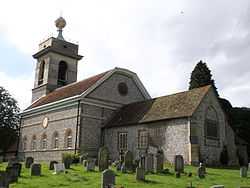St Lawrence's Church, West Wycombe
| St Lawrence's Church, West Wycombe | |
|---|---|
| The Church of St Lawrence, West Wycombe | |
|
The church in 2009 | |
| 51°38′50″N 0°48′20″W / 51.647154°N 0.805624°WCoordinates: 51°38′50″N 0°48′20″W / 51.647154°N 0.805624°W | |
| Location | West Wycombe |
| Country | England |
| Denomination | Church of England |
| History | |
| Dedication | St Lawrence |
| Architecture | |
| Heritage designation | Grade I listed church |
| Designated | 9 January 1954 |
| Architect(s) | Widely believed Nicholas Revett |
| Completed | 3 July 1763 |
St Lawrence's Church is a Church of England church in the parish of West Wycombe, Buckinghamshire, England. It sits on top of West Wycombe Hill, which is managed by the National Trust,[1] although the church and graveyard are owned by the Church of England.
There has been a religious focus on this site since at least 635AD. The Grade I listed church[2] was built in its current form from 1761, under instruction from Sir Francis Dashwood, 1st Baronet and Baron Le Despenser. It was officially reopened on 3 July 1763.[3]
The architect is unknown but is widely believed to be Nicholas Revett,[4] who also worked on parts of the house at West Wycombe Park.
St Lawrence's Church is known as the 'Summer Church' and St Paul's in the heart of the village is known as the 'Winter Church'. This is because until 1928 there was no road up to St Lawrence and no power until the 1970s.
The tower
The tower is 80 feet (24 m) tall, with the golden ball adding another 20 feet (6 m). The top is 646 feet (197 m) above sea level.[4]
Bells
There are eight bells in the tower: the treble and second by Mears & Stainbank, 1923; the third by Lester and Pack, 1756; the fourth by Henry Knight, 1621; the fifth by Joseph Carter, 1581; the sixth by Henry Knight, 1620; the seventh by Lester and Pack, 1762; and the tenor by Thomas Mears, 1828.[5]
 |
The bells ringing at St Lawrence's Church
Remembrance Sunday 2012 |
| Problems playing this file? See media help. | |
Golden ball
The golden ball can be seen for miles around and is a recognised symbol of West Wycombe village. It is made from a wooden frame covered in gold leaf, 8 feet in diameter, and contains seating for up to six people.[4][6] There were rumours that the Hellfire Club, founded by Sir Francis Dashwood (1708–1781), met inside the golden ball,[4] but there is no evidence for that. It is no longer possible for the public to enter the ball. It has been suggested that Sir Francis Dashwood used a heliograph to signal through a porthole in the golden ball to his friend, John Norris (1721–1786), who had erected a tower, now known as the Camberley Obelisk, near his home at Hawley, Hampshire, 21 miles to the south.[6]
References
- ↑ "West Wycombe Village and Hill - National Trust page".
- ↑ "Details from listed building database - Grade I".
- ↑ "Victoria County History - West Wycombe Churches".
- ↑ 4.0 4.1 4.2 4.3 Lacey, Nigel (2006). A Guide to St Lawrence's Church and West Wycombe Village.
- ↑ http://dove.cccbr.org.uk/detail.php?searchString=West+Wycombe&Submit=+Go+&DoveID=WEST+WYCOM
- ↑ 6.0 6.1 Dashwood, Francis (1987). The Dashwoods of West Wycombe. Aurum. p. 220. ISBN 9780948149771.
External links
| Wikimedia Commons has media related to St Lawrence Church, West Wycombe. |
